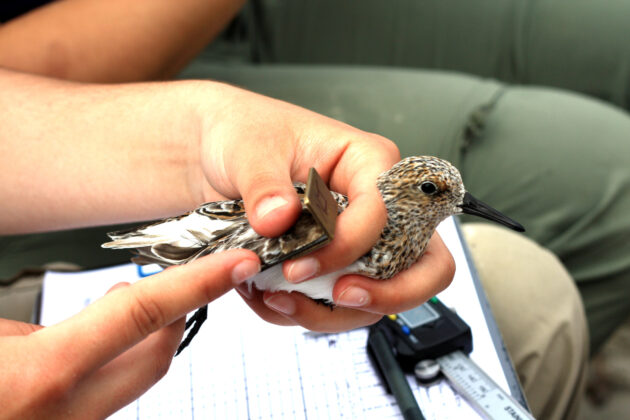The cacophonous sound of shorebirds is deafening.
I’m huddled behind tall beach grass repeating the instructions for the task before me in my mind. “I hope I don’t screw this up,” I think to myself.
On the beach, out of view, are two volunteers, called twinklers, strategically walking to “push” a flock of red knots toward the net the team placed and covered with sand just beyond the grass.
The sense of excitement is palpable as the chatter exchanged over Walkie Talkies increases. Then boom, the sonic blast of the net firing jolts me back into the moment.
It’s time to grab a plastic bin and run to the beach and find a spot along the net, wriggling with squawking shorebirds, and assist researchers in collecting red knots, ruddy turnstones, and sanderlings so the team can survey and study these at-risk creatures during their brief stopover in New Jersey.
This is Conserve Wildlife Foundation’s Delaware Bay Shorebird Project. I was lucky enough to join my Geraldine R. Dodge Foundation colleague Naeema Campbell for a day of bird banding, learning about the incredible conservation effort that has helped bring these birds back from the brink.

I arrived at North Reeds Beach in Middle Township just after 6 a.m. and was astonished to see in front of me red knots scouring the surf, dipping their long, skinny beaks into the sand in search of horseshoe crab eggs, exactly as I’d observed from the comfort of my home in a NATURE documentary years earlier.
Red knots, with their sand-speckled wings and dusty orange underbellies, are small enough to fit inside the palms of your hands yet they take one of the world’s longest journeys — some more than 18,000 miles — from the tip of Argentina to their breeding grounds in the Canadian Arctic and back. They make a crucial stop at New Jersey’s Delaware Bay to feast on horseshoe crab eggs, regaining lost weight in preparation for the last leg of their trip.
A sharp decline of horseshoe crabs due to over-harvesting resulted in a sharp decline in the red knot population — from more than 90,000 seen in 1989 to just 25,500 in 2015, according to Conserve Wildlife.
In the wake of Hurricane Sandy, which caused severe erosion along these beaches, the knots faced another hurdle. Conserve Wildlife worked with a coalition of conservation groups and government agencies to restore the shoreline. With a grant from the New Jersery Recovery Fund and other philanthropic and government funding, the beaches were ready just in time for horseshoe crab spawning season and the return of the red knots.
You can watch a documentary about the effort, including a short version (below) or the full-length version here.
Without a Day to Spare from Greener New Jersey Productions on Vimeo.
This has been a good year for red knots, according to Larry Niles, who has led efforts to protect red knots for more than 30 years.
“Most came in better-than-average condition, so they had a head start,” he said in one of his latest blogs tracking the project. “Throughout the stopover a majority of the bay’s population foraged on the eggs laid by vigorously spawning horseshoe crabs. On one day we saw a 10,000 red knot flocks on North Reeds Beach happily roosting and feeding on the abundant eggs.”
An international team of researchers led by Conserve Wildlife — some who make the trip annually from New Zealand and Canada — converges in the Delaware Bayshore for a month beginning with the arrival of the red knots to monitor the birds’ weight throughout their stopover, holding two or three “catches” each week, depending on conditions.
On the day Naeema and I visited in mid-May, we collected data on 120 red knots, 85 ruddy turnstones and two sanderlings. When the team split into groups of six, huddling close seated on smal l camping chairs around makeshift tables, us Dodgers joined the small radio-tagging team.
l camping chairs around makeshift tables, us Dodgers joined the small radio-tagging team.
Naeema and I had the task of holding the shorebirds in our hands as researchers carefully clipped a small area of feathers on their back and glued on the tiny receptors that enable scientists to track them.
Some of the birds were more vocal than others — a few of the ruddy turnstones did not like being in my grip — but for the most part, they were docile as we respectfully carried out our work.
Without a doubt, the best part of the day was the release — placing the birds on the beach and watching them hop and take flight, knowing you’ve shared a moment with this creature, been part of its miraculous journey.
-
To learn more about Conserve Wildlife’s Delaware Shorebird Project and support their efforts to protect New Jersey’s rarest animals, please click here.
Meghan Jambor is the Dodge Foundation’s communications manager. For more information on the Dodge Foundation and its environmental grantmaking, click here.
